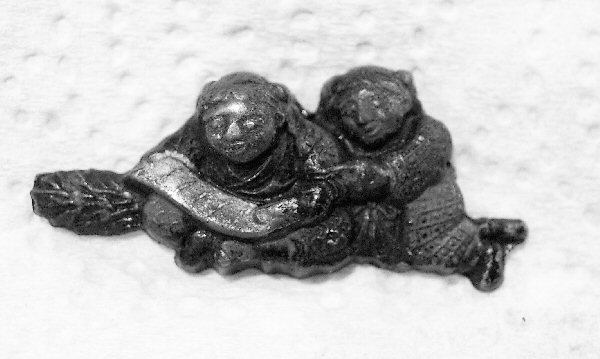

| Home | Knifemaking | Leatherwork | Wood | Links and other stuff |
|---|
| Artificer: [ART-IF-ISS-URR] : Noun: A craftsman who makes things |
Restoration of a Daito - work in progress: part 1.I was given a daito by my Sensei, who was bequeathed it by one of his teachers.The blade had at some point had a very hard life, being apparently struck against a hard object like a tree, putting a severe bend in the blade, both laterally and in the plane of the blade. The distortion was so bad that the sword would not fit into the saya (scabbard), and I was given the sword in pieces - literally a basket case.  An appraisal had been done on the sword by a respected UK authority, and a second opinion from an authority in Hong Kong confirmed the initial report - the signature on the tang was not who it purported to be. I gather that this is not uncommon, and does not necessarily mean that the blade is not old, merely that it was not made by a well-known smith. The form of the blade suggests late 17th century origin, or so I am informed, and I am happy to accept that appraisal, not being in any way learned in this subject. Having determined that the blade was of no significant value, I decided to proceed with restoring the piece. Designing a jig to straighten the longitudinal bend, without allowing further lateral distortion, took some time. When built, the jig was NOT pretty, being built purely for rigidity from two lengths of very old 6x2 roofing timber, but it did the required job , allowing me remove the co-planar bend and restore the blade to it's original profile (as evidenced by the existing saya). The lateral bends were then easily removed using the normal 3-blocks in a vice method. The koshirae (fittings) are a mixture of modern-era and older - the saya and tsuka appear to be 1930's military mounts, suggesting that an older blade had been re-fitted for use on military service. Closer inspection reveals the tsuka to be made from a section of a saya, as revealed by the presence of a pocket for a kozuka (hilt knife), and the fact that the slot for the tang goes all the way through the tsuka, and has been spaced out with small pieces of wood to fit the tang. Some recycling, 1930's style! The tsuba (guard) is a plain iron item, sized for the smaller wakizashi or shoto (literally, small sword), and is probably from another piece entirely. 
Rather than try to restore the existing fittings, I decided to make a new set of fittings (koshirae), more in the style of the apparent period of the blade, but retaining some of the existing fitments, namely the fuchi (hilt collar), kashira (pommel) and menuki (hilt ornaments). The existing habaki (blade collar) is badly damaged, and as above the tsuba is a wakizashi-sized item, so I needed to construct new ones, as well as the tsuka and saya. I removed the fuchi, kashira and mekuki for cleaning, and Carol at PhotoDiva has kindly taken some photos of them - you can tell they're not my photos, as they are far too good! Click the pictures for full-size pictures, bearing in mind that the linked photos are big files, so be warned if you are on a slow connection... Fuchi and kashira: Kashira showing the other side: Omote-side menuki (side facing outwards): a hawk in a pine or ginkgo tree. And the ura-side menuki (side facing inwards): two sages reading from a a scroll...  I made up a new habaki from brass sheet from the Box of Useful Items, and a new tsuba from copper - photos to follow as soon as I manage to take some! A tsuka core and a saya have been built from yellow poplar - this should strictly be honoki (magnolia) but this is really difficult to get hold of outside Japan. Yellow poplar or tulipwood is not actually a poplar, but is a member of the same genus as the magnolia, so a very close relative. Again, photos to appear when I've taken them....
|
Copyright Peter Nicholson 2009. And just for spam-bots
everywhere:  |